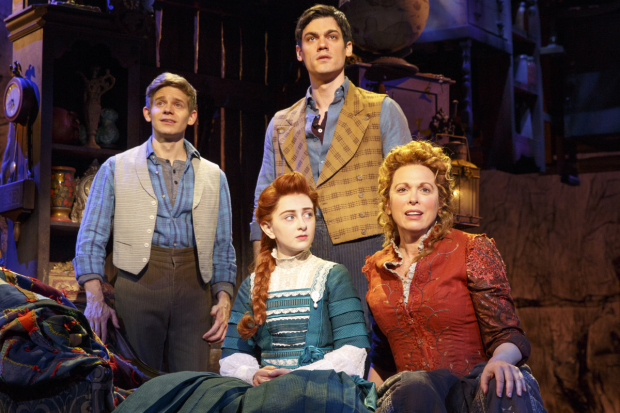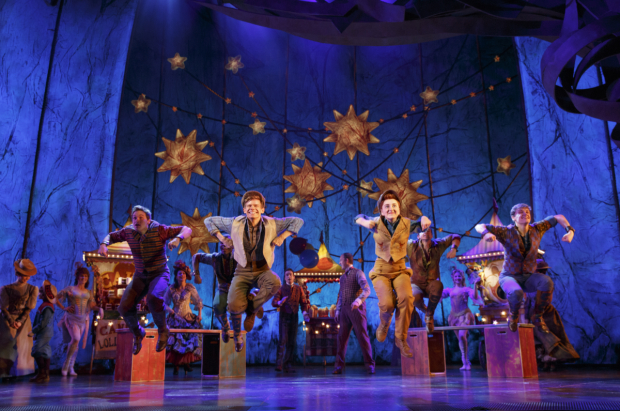Tuck Everlasting

(© Joan Marcus)
Parents looking for a poignant yet family-friendly show might want to consider Tuck Everlasting, the new Broadway musical based on the novel by Natalie Babbitt. But they might also be better off looking elsewhere.
The musical has had a somewhat tumultuous path to New York, canceling a 2013 pre-Broadway engagement in Boston because of the lack of an available Broadway theater for later that season. It eventually made its world premiere at Atlanta's Alliance Theatre in 2015. With the show in a new home at the Broadhurst, it is clear that the reasons behind Tuck's roundabout path to Broadway go beyond real estate.
The show tells the story of Winnie Foster (Sarah Charles Lewis), an 11-year-old girl living with her protective mother (Valerie Wright) and grandmother, Nana (Pippa Pearthree), at the end of the 19th century. One day, she decides to run away to her family's woods. In the forest she meets Jesse (a puckish Andrew Keenan-Bolger), the youngest son of the Tuck family. While he outwardly appears 17, he's actually 102. Along with his mother, Mae (Carolee Carmello), his father, Angus (Michael Park), and his brother, Miles (Robert Lenzi), Jesse became immortal when they drank from a spring in those very woods. Since Winnie has stumbled upon their secret, they decide to kidnap her. But don't worry: They're not going to hurt her! The same cannot be said of the Man in the Yellow Suit (Terrence Mann), who has been stalking the Tucks for years, hoping to cash in on their secret.
A staple of elementary school syllabi, Babbitt's novel is a dreamy meditation on the implications of immortality. The author employs copious metaphor and personification (a cottage says "touch me not" and a herd of cows is "very wise indeed") in her tale of a runaway falling in with a mild-mannered family of immortals. One of the novel's charms is its mystery, which asks young readers to exercise their imaginations: What part of the country are we in? Why is Winnie so sheltered? Who exactly is that man in the yellow suit?
In their attempt at an earnest adaptation, book writers Claudia Shear and Tim Federle frustratingly choose to answer those questions (New Hampshire, her dad is dead, a carnival barker), sapping the tale of an element of burlesque. One suspects that Federle (who penned the delightful Nate series of young-adult novels) helps to lend an affable humor to a story that was sorely lacking, but writing a book to a musical also requires structure. Here, the plot is so disjointed that it is often hard to tell how we got where: A late-coming scene in the second act in which Winnie and Angus sing about the water cycle ("The Wheel") feels like it was crammed in there because it is a thematically essential scene for which the writers could find no other place.
Chris Miller and Nathan Tysen's score is hit-and-miss, with some songs helping to further the plot ("Story of the Tucks") while others stop the show in its tracks ("You Can't Trust a Man"). Tysen employs some clever wordplay and Miller writes lovely melodies that are unfortunately undermined by John Clancy's thin and tinny orchestrations. Hearing what sounds like an electric dulcimer, we begin to feel more like we're watching a scene from Liberty Square in the Magic Kingdom than something authentically from a bygone American era.

(© Joan Marcus)
Mann injects some mystery back into the proceedings with his nomadic dialect, but as far as villains go, he's one step above British pantomime. Nana speaks for all of us when she delivers the show's funniest line to this pitiful antagonist: "You're an evil banana!"
Park, Carmello, Keenan-Bolger, and Lenzi do a fine job portraying the kindly (if somewhat boring) Tucks. Lenzi and Keenan-Bolger exhibit a brotherly tension that feels important (until it is mostly ignored by the remainder of the script). The perfectly maternal Carmello sounds radiant as ever in her big number, "My Most Beautiful Day."
Leading the cast, the super-talented Lewis (in her Broadway debut) plays Winnie with technical proficiency but an emotional flatness that remains consistent, giving us no sense that our protagonist has actually gone on any sort of journey. Habitually perky, she is nothing like the "very cross, very near the boiling point" little girl of the novel.
Director Casey Nicholaw opts to drown the script in a tidal wave of production elements. While Gregg Barnes' period costumes are typically lovely, Walt Spangler's set is aggressively unattractive and lacks in the dreamlike quality we would expect. Much of the set is dominated by a giant tree that looks like it came from a corporate atrium: It's hulking and cold. Clumps of fiberboard leaves float over the stage, helping to create a fully realized tree-climbing scene, but otherwise awkwardly taking up space.

(© Joan Marcus)
Nicholaw's choreography is equally maximalist, and the ensemble rises to the occasion, leaping, twirling, and tumbling throughout. The first-act showstopper, "Partner in Crime," is truly spectacular for the level of commitment exhibited by the cast. Still, the dancing often feels like window dressing, jumping as high as it can to distract us from substandard material.
The one exception comes near the very end in a ballet that tells the story of an entire life. Using specific gestures and familiar imagery, we see the bittersweet cycle of birth, coupling, and death that makes up our existence. It is beautiful in its simplicity, and every moment is crystal clear. It leaves us wishing that this spirit could have been applied to the previous two hours.










